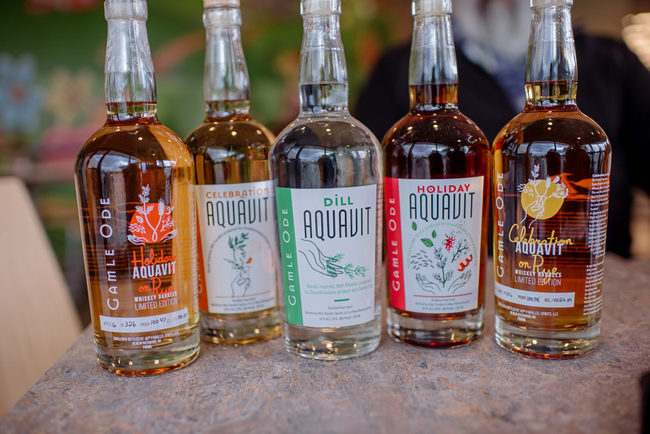
This story is a product of Heavy Table’s first Listening Session, underwritten and hosted by the Lakewinds Food Co-op. On May 23, we interviewed 15 local food artisans over the course of eight hours, with a goal of taking a snapshot of the vibrant Minnesota food scene.
Say “aquavit” and you get a variety of responses. Blank looks; nods from people whose Scandinavian parents or grandparents have been drinking the dill- and/or caraway-infused stuff since the beginning of time; and enthusiastic raised eyebrows from a new breed of bartenders and drinkers who are discovering fresh expressions of the spirit during a new, anything-goes era of artisan distilleries and craft cocktails.
Minnesota’s Gamle Ode is an aquavit company that straddles the old and new schools of the beverage. Its classic distillation of aquavit goes heavy on the dill, but it’s fresh dill fronds — rather than dill seed — which imparts a gentler, almost fragrant herbal flavor instead of the more aggressive attack found in some of the more typical Scandinavian varieties.
The company also has some innovative spins. Its Holiday variety changes things up from the conventional aquavit. Gamle Ode founder Mike McCarron says, “Holiday is six ingredients — the original dill, caraway, and juniper, and then mint, allspice, and orange peels. I think [the mint] pairs well with the dill, as far as the freshness.”

And McCarron has taken things a step further by aging both Holiday aquavit and his more traditional Celebration variety on rye whiskey barrels to create an Old-World-meets-New beverage with enough depth and complexity to stand on its own in a glass with ice.
“When I first started, aquavit was on no-one’s tongue, but now you’re seeing it more and more,” says McCarron. “It’s like a gin. You can get it on the market earlier, but it’s also like a whiskey, where you can throw it into a barrel and see how it tastes in three, four, or five years. As far as I know, I’m ahead of the curve on that.”
“The original Holiday was a failed version of the dill, but it was still good juice, and we didn’t want to give up on it. So we decided, ‘let’s reinfuse it’; add the holiday ingredients (menthol, spice, and orange peels) and throw it into some barrels and let it sit. This version is about nine months in barrels.”

The result (when the spirit is aged on rye barrels) is an herbal spirit with a subtle, woodsy depth. It’s not aggressive, and you’re not going to confuse it with whiskey, but it’s a step beyond any aquavit you’ve tasted before. “[The aquavit] pulls the rye out of the wood and then it becomes an additional note that you pick up as you’re drinking it,” says McCarron. “It’s in balance.”
We asked McCarron about his plan for his rye-barrel-aged spirits, and it soon became clear that he’s a play-it-by-taste kind of distiller, not a guy driven by marketing. “To be honest, I don’t know what people want,” he says. “I get a lot of confused looks, even from bartenders, because it’s so different. But as the years get on, and other aquavits get out there, people will start to find a space for it.”
The quest for something original is part of Gamle Ode’s identity. “A lot of distilleries begin [by] trying to get something that tastes like Jack Daniels,” says McCarron. “And then later, on their 15th batch, they ask, ‘Well, what’s the point?’ And so then, they start to spread their wings. I think that’s where we’re at with these rye versions. I think we’re going to have fun with this. We’re still only in the early stages, with less than 10 barrels up right now. The challenge, I guess, is to decide how big to go, and how quickly to get there.”


